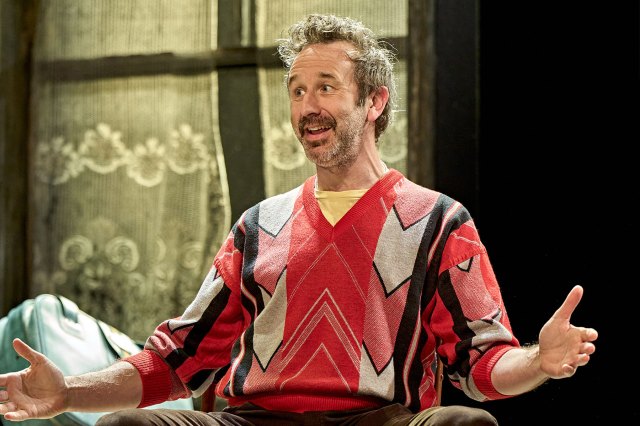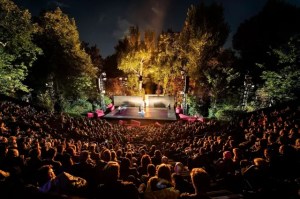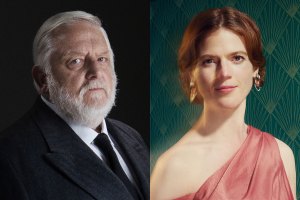The Brightening Air with Chris O’Dowd at the Old Vic – review
Conor McPherson’s new play runs until 14 June

There’s a strong sense of the numinous in the writing of Conor McPherson. From his first hit The Weir to the Bob Dylan-inspired musical Girl From the North Country, there’s always a feeling of something mysterious and magical lurking in the air, beyond the human world.
This is particularly true in The Brightening Air, his first straight play for 12 years, a family saga set in a crumbling farmhouse in rural Ireland in the 1980s. The chickens are both on the loose thanks to the carelessness of Billie (Rosie Sheehy) who lives her with her brother Stephen (Brian Gleeson) and about to come home to roost in the shape of their older sibling, Chris O’Dowd’s raffish Dermot, who swaggers in with a whisky bottle in his hand and a young girl on his arm.
McPherson assembles his ensemble with considerable aplomb. In addition to the immediate family, there’s an old, blind defrocked priest Pierre, gracefully and subtly embodied by Seán McGinley, and his housekeeper, Derbhle Crotty’s Elizabeth, blousy, disappointed and pragmatic. Setting the table with sandwiches is Dermot’s estranged wife Lydia (Hannah Morrish), desperately in love with him and pleading for some magical water that will make him love her back. Oh, and a farm labourer Brendan (Eimhin Fitzgerald Doherty, gently touching) hanging around looking longingly at Billie, who is both lost in her own autistic world and clear-sighted about her future.
There is, in short, a lot going on. The Brightening Air owes many debts in many directions, but most particularly to Brian Friel, WB Yeats (from whose poem “The Song of Wandering Aengus” the title is taken) and Chekhov, whose Uncle Vanya McPherson adapted in 2020. But it also has its own character, a sense of suspended animation emphasised by Rae Smith’s design (enhanced by Mark Henderson’s lighting) that creates a set of delicate screens, like misty Japanese prints, to frame more naturalistic furniture.
Fitfully, The Brightening Air is utterly wondrous. The first two acts of its four-act structure are beautifully atmospheric, dancing a clever line between comedy and melancholy, realism and magic. All the characters are to some extent stuck on the wrong road, longing for change that doesn’t necessarily materialise, pointlessly in love with the wrong people.
They also each have a mysterious double self. Freya (spikily played by Aisling Kearns) is Dermot’s unsuitable younger girlfriend – “She’s in her 20s. Well, 20. Next year” – but she might also be a witch, a changeling child; Pierre seems holy, but he is harbouring radical thoughts about God and the Devil. There’s a constant sense of magic, of the unknown influencing behaviour, of spells cast. But there are also the lurking demons of poverty, violence and alcoholism.
McPherson’s writing is pin-sharp, a rare combination of the riotous and the elegiac. Elizabeth describes being the housekeeper to a priest as “like skipping the fun part of a marriage and just getting straight to the celibacies.” Freya talks about God weeping “into the mercy of the void.” The language is constantly involving.
But he simply tries to cram too much in. By the second act, revelation and twist follows revelation and twist without room to breathe. Chekhovian nuances land with the impact of a hammer. McPherson is also serving as director, and it’s hard not to wonder whether another, different eye might have helped him chart a sharper course. It’s as if having been silent for a while, his ideas are just bursting forth.

Yet The Brightening Air is constantly gripping, elevated by commanding performances from the entire cast, both finely detailed and yet somehow soaring. O’Dowd is superb as Dermot, leaning into his monstrous self-absorption, timing each line for maximum impact. Gleeson brings troubled depth and underlying anger to the put-upon Stephen, whose passivity is his doom.
And as Billie, a figure of both limitation and insight, Sheehy is utterly devastating. Her resilience owes something to Sonia in Uncle Vanya, but Sheehy adds a layer of vulnerability that is completely compelling.
It’s a frustrating play, always watchable, so nearly great, so nearly soaring, yet somehow held earthbound by the weight of its intent.
















